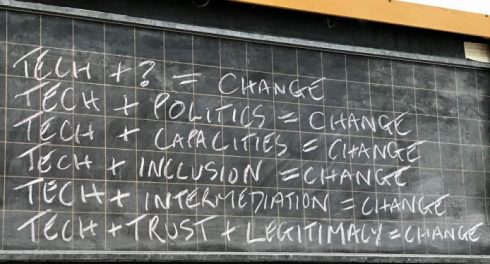How can governance funders improve funding decisions? Find our checklist of questions to consider when reviewing funding proposals and designing data components.
 Photo: qimono at Pixabay
Photo: qimono at Pixabay
In 2018, TAI synthesized lessons learned on improving the effectiveness and impact of funding for the production, disclosure, use, and impact of data for transparency and accountability (“governance data”). In an effort to ensure these insights can be put into action to inform and improve funding decisions, we developed a short list of questions (below) for funders and their grantees to consider and discuss when reviewing funding proposals and designing governance data activities. The aim is to help funders and their grantees to identify and explore key barriers to impact along the “data value chain” (see here and here), and how grants could be enhanced or supplemented with other investments or by other funders to improve outcomes.
Questions for funders and grantees to consider and discuss when designing governance data programs, components, or activities:
- Would the grant be able to produce or leverage governance data that is actionable (relevant/aligned with demand, timely, credible, and accessible)?
- Have governance data users and use cases been clearly identified and would users be engaged during the course of the project? Have gender-specific barriers to data use been considered?
- Are activities to promote data use designed to address a context-specific governance problem (i.e. corruption in sub-national expenditure in X country)?
- Would data activities at the country level leverage existing governance/open data reforms, institutional frameworks and “moments”?
- Does the grant plan to measure and monitor governance data-related outcomes, including data use and impact on decision-making, engagement and accountability?
To test the relevance and utility of these questions for TAI members, we reviewed a handful of past proposals shared by TAI Program Officers alongside these questions. This exercise was helpful in highlighting potential gaps in these proposals and areas that could benefit from further discussion or clarification, plus some challenges in using these questions for any governance data-related funding.
Starting with proposal gaps, insights include:
1. Would the grant be able to produce or leverage governance data that is actionable (relevant, timely, credible, and accessible)?
- At the global level, it was not always clear how governance data would be made relevant and responsive to the needs of country policymakers and advocacy groups.
- At the country-level, limitations regarding governance data availability, quality, credibility, and feasibility are often key barriers to achieving meaningful data use. While some proposals aim to address supply-side issues through efforts to promote disclosure and alignment with global data standards, the broader extent of these challenges (in terms of capacity, incentives, infrastructure, resources and legal/regulatory frameworks for governance data production and disclosure) does not seem to be fully considered or acknowledged as a risk to achieving long-term outcomes. It might be helpful to consider risk mitigation strategies, and whether coordination or partnerships with other initiatives that aim to strengthen the enabling environment for data disclosure and access might be helpful in addressing some of these barriers.
2. Have governance data users and use cases been clearly identified and would users be engaged during the project? Have gender-specific barriers to data use been considered?
- For broader proposals (i.e. for general support grants), data use was included as an objective, although few details are provided on activities directly supporting the use and targeting specific users. Some proposals also do not indicate whether and how data users have been or would be engaged to understand their needs and solicit their input or feedback.
- For proposals more narrowly focused on governance data use, there is a clearer focus on users targeted (i.e. open government champions in sub-national agencies), although it is not clear to what extent the project would seek to understand and address their specific data needs and capabilities before embarking on ways to promote use.
- None of the proposals considered the specific data needs, preferences or barriers to use among women or other marginalized groups.
3. Are activities to promote data use designed to address a context-specific governance problem (i.e. corruption in sub-national expenditure in X country)?
- The starting point for activities promoting data use tends to be the data itself (i.e. fiscal data or extractives data) and identifying ways to use those data. This is opposed to an approach that identifies problems that target users are grappling with, and then considering whether and how data (governance and otherwise) might be needed as part of the solution.
4. Would data activities at the country level leverage existing governance/open data reforms, institutional frameworks and “moments”?
- Most of the proposals include details on how activities at the country-level would align with local political contexts and institutional needs; however, it is not clear how support for global governance data would be shaped by country reform priorities and agendas (as opposed to the other way around). Additionally, few proposals consider how to leverage open government commitments, open data policies, the right to access information laws, etc. to provide further momentum and support to institutionalize changes in data disclosure and use.
- There is also limited consideration given to the capacity and incentives of governments to engage with and respond to the analysis and advocacy efforts supported by the grants, which is needed to secure lasting reforms.
5. Does the grant plan to measure and monitor governance data-related outcomes, including data use and impact on decision-making, engagement, and accountability?
- Most of the proposals include data disclosure and use as outcomes to measure progress against. However, linking data use to governance outcomes (for example, identifying the role of data in influencing actions such as advocacy, engagement, and reforms) do not seem to be part of their monitoring, evaluation, and learning.
This exercise also uncovered some challenges to using this approach as an investment guidance tool, including:
- It is not always clear what should count as a governance data-related grant. TAI members often provide resources as general support or institutional strengthening grants, which can encompass a range of activities, objectives, and actors, many of which may or may not explicitly involve data. This makes it challenging to review these proposals for details on data-specific activities and to discuss these aspects of the grant with prospective grantees.
- Along similar lines, not all grants to support transparency and accountability will have data-specific components or strategies, although it is helpful to consider whether they should. Data may not be a central component of a transparency and accountability organization’s strategy or theory of change, although access to and use of data could be integral to the success of the grant. It could be the case that the role of data has not been specified or highlighted – for example, in activities supporting budget analysis or information campaigns. It would be helpful to discuss whether data-specific activities (as distinguished from broader knowledge or analytical work) should be integrated into an overall grant strategy or whether the grantee might partner with other data-driven efforts to complement its approach.
- There is a need to distinguish between global governance data to measure transparency and accountability, and country-level governance data to provide greater transparency on the use of public resources or government performance. TAI members invest in both types of governance data with distinct aims and barriers to data quality, use, and impact, making it difficult to assess implications across a wide range of data-related initiatives.
Are you funding projects that include data use? Are you running programs that involve governance data? We would welcome your thoughts on what resonates here and feedback on using the questions. Reply to this thread or reach us directly.
This blog was written by Liz Dodds.


